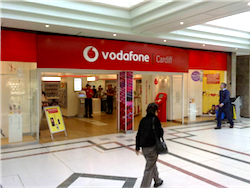Standards need to come into force to enable Machine-to-Machine (M2M) communications to be carried across 4G LTE at the same price point as it currently transmits over 2G GSM networks, according to Vodafone.
During the Future of Wireless International Conference on Monday, Vodafone presented a session on “Making LTE fit for the Internet of Things (IoT)”, where it examined the technical and economic challenges that remain as M2M applications start to mature.
“Vodafone Paknet [the UK’s only dedicated M2M nationwide network in operation since 1989] uses the 160MHz frequency band and in that band we are able to run a network very efficiently with much fewer mobile sites than we need for cellular,” said David Lister, Research Manager, Vodafone Group.
However, the use of M2M communications is growing rapidly on cellular networks.
Vodafone now serves 11.1 million M2M subscriptions on its cellular global platform, which has grown in one year by 40 percent from 7.8 million.
To Lister, this is one of the big business opportunities in the operator’s roadmap.
“GSM and 3G are relatively mature technologies from an operator’s perspective, [while] LTE is seen as a way for us to deliver mobile broadband services to our customers.”
Vodafone is now looking to use LTE networks to drive M2M services.
At present, there are enterprise-focused devices delivering M2M connectivity on LTE, known as “Category 3”. These are low in volume but high in value, requiring high bandwidth (100Mbps +) and low latency, such as CCTV video cameras, digital signage and smart grids.
There are also industrial M2M products, which are high volume but run on low bandwidth (1Mbps). These devices are currently served by GSM networks and can be switched over to LTE provided the cost point is brought down to be comparable to GSM, according to Lister.
“Being able to operate efficiently from an operator cost perspective is key to any operator. M2M is still a relatively small business compared to mobile broadband. Whilst the total market value is increasing exponentially, the revenue per connection is [currently] USD$5 per connection per month, with a projection for it to come down to USD$2 per connection.
“If the revenue is coming down, then as a business we need to drive the costs down.”
Vodafone is currently assisting the global M2M standards body, which is working on Release 12. The new standard focuses on low-cost and enhanced coverage specifically machine-type communication for LTE and is due to be standardised by the end of 2014.
“[Release 12] is on the back of quite a substantial piece of work known as the “Study Item” that has already been completed. [The study item] recommended that LTE devices should have a single receiver antenna, that peak data rates should be reduced to 1 Mbps, that the bandwidth should be reduced to 1.4 MHz, and that coverage should be increased for existing LTE devices. There are also optional recommendations about increasing energy efficiency.”
Lister stressed that economies of scale and global roaming are both going to be essential.
“Without a common standard globally, we’re always going to be constrained to localised national solutions which always end up being fragmented and reduce the opportunities to true connectivity, [but] it’s not just about standards,” he said.
“My view is that today there just isn’t an ability to use a licensed-exempt spectrum band which will give that global economy of scale across a common technology. White space is a very interesting opportunity, but it remains to be seen if the regulators across Europe, if not the world, embrace that with a view to having a similar model to what the UK and Ofcom are trialling.”




